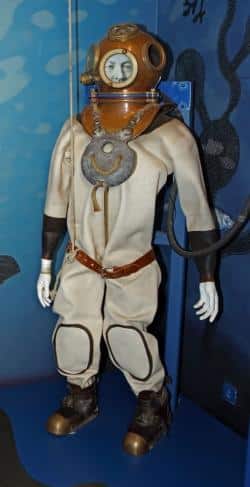Jules Verne, writer of images
Jules Verne’s body of work cannot but conjure up a world of images. From Journey to the Centre of the Earth to Twenty Thousand Leagues under the Sea by way of Around the World in Eighty Days, Jules Verne fills his stories with details that invite his readers to make their escape and travel the world. Texts further enhanced by Editions Hetzel’s engraved illustrations, which dialogue seamlessly with the stories.
These extraordinarily evocative worlds were soon transposed to the theatre, and later to the cinema.
Apart from such adaptations, Jules Verne’s body of work has continued to inspire authors and creators, giving rise to multiple interpretations and production of countless new images.
Here, a selection of artists’ original works, from the 19th to the 21st century, bears witness to this profusion of images and their extraordinary vitality…
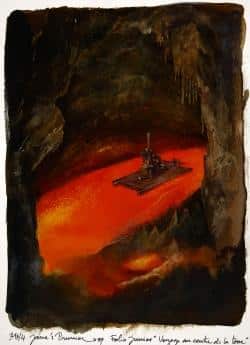
Jame’s Prunier
Journey to the Centre of the Earth
Illustration for the adaptation of Jules Verne’s novel Journey to the Centre of the Earth
Gallimard Jeunesse publishing house, 2004
Gouache and watercolour on paper
MJV C566 (Purchased from the artist, 2006)

Didier Graffet
Nautilus in the cave
Illustration for the adaptation of Jules Verne’s novel The Mysterious Island
Gründ publishing house, 2005
Acrylic on paper
MJV C491 (Purchased from the artist, 2012)

Didier Graffet
Nemo dying in the Nautilus
Illustration for the adaptation of Jules Verne’s novel The Mysterious Island
Gründ publishing house, 2005
Acrylic on paper
MJV C492 (Purchased from the artist, 2012)
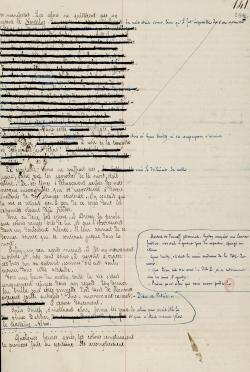
Jules Verne
The Mysterious Island, chapter XVII
Autograph manuscript, 1873
MS 83-13 – Exhibition print
Captain Nemo is going to die; he speaks his last word: « Independence ». And Jules Verne corrects this first intention: « Independence » becomes « God and Country ». It was no doubt the publisher Hetzel that forced Jules Verne not to express a value dear to his character and to himself.
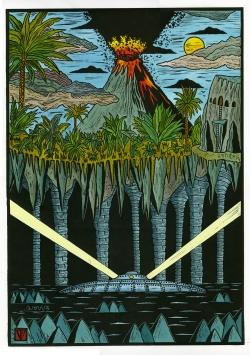
Frédéric Voisin
The Mysterious Island
Linocut, 2020
(Purchased from the artist, 2023)

Jame’s Prunier
The Mysterious Island
Illustrations for adaptation of the novel novel The Mysterious Island
Gallimard Jeunesse publishing house, 2000
Gouache and watercolour on paper
MJV C567 (Purchased from the artist with support from the Fonds régional d’acquisition pour les bibliothèques, 2006)

Jules Verne, Celebrated Travels and Travellers
Engraved wooden matrix
Circa 1879
Jules Verne, The Will of an Eccentric
Engraved wooden matrix
Circa 1899
The evolution of printing techniques steps up the role illustrations play in the way the story unfolds. End grain wood engraving: a block cut perpendicularly to the direction of the wood fibre and worked with a burin, provides a very fine, highly detailed engraved image in relief, as well as a being a robust medium that can be placed in a printing press for simultaneous printing of text and illustration.
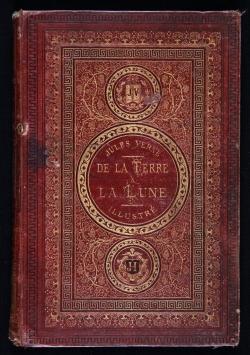
Jules Verne
From the Earth to the Moon
Cartonnage binding “with initials”
Éditions Hetzel, Paris, 1875-1890
MJV A2796
Christmas gift books are ceremonial items, intended to be looked at more than read. Paper and typography quality, the value of their brightly coloured percaline bindings and decorated covers all contribute to making such publications high-prestige editions. But it’s also the richness and abundance of the images that embellish the book’s pages that provide it with major artistic value.

Frédéric Voisin
Journey to the Centre of the Earth
Linocut, 2020
MJV C588 – C589 (Purchased from the artist, 2023)
A graduate of the National Higher School of Applied Arts in Paris and holder of a Master’s in Engraving from Camberwell College of Arts in London, Frédéric Voisin began his career in the early 1980s, starting out as an illustrator for the press and in the field of music. He gradually devoted himself to the art of the print and the linocut technique.
A fan of imaginary worlds, in 2020 he explored the universes of Jules Verne’s novels and created four matrices interpreting Journey to the Centre of the Earth, Twenty Thousand leagues under the Sea, The Mysterious Island and Robur the Conqueror.
Black-and-white and colour prints were made for each of these works.
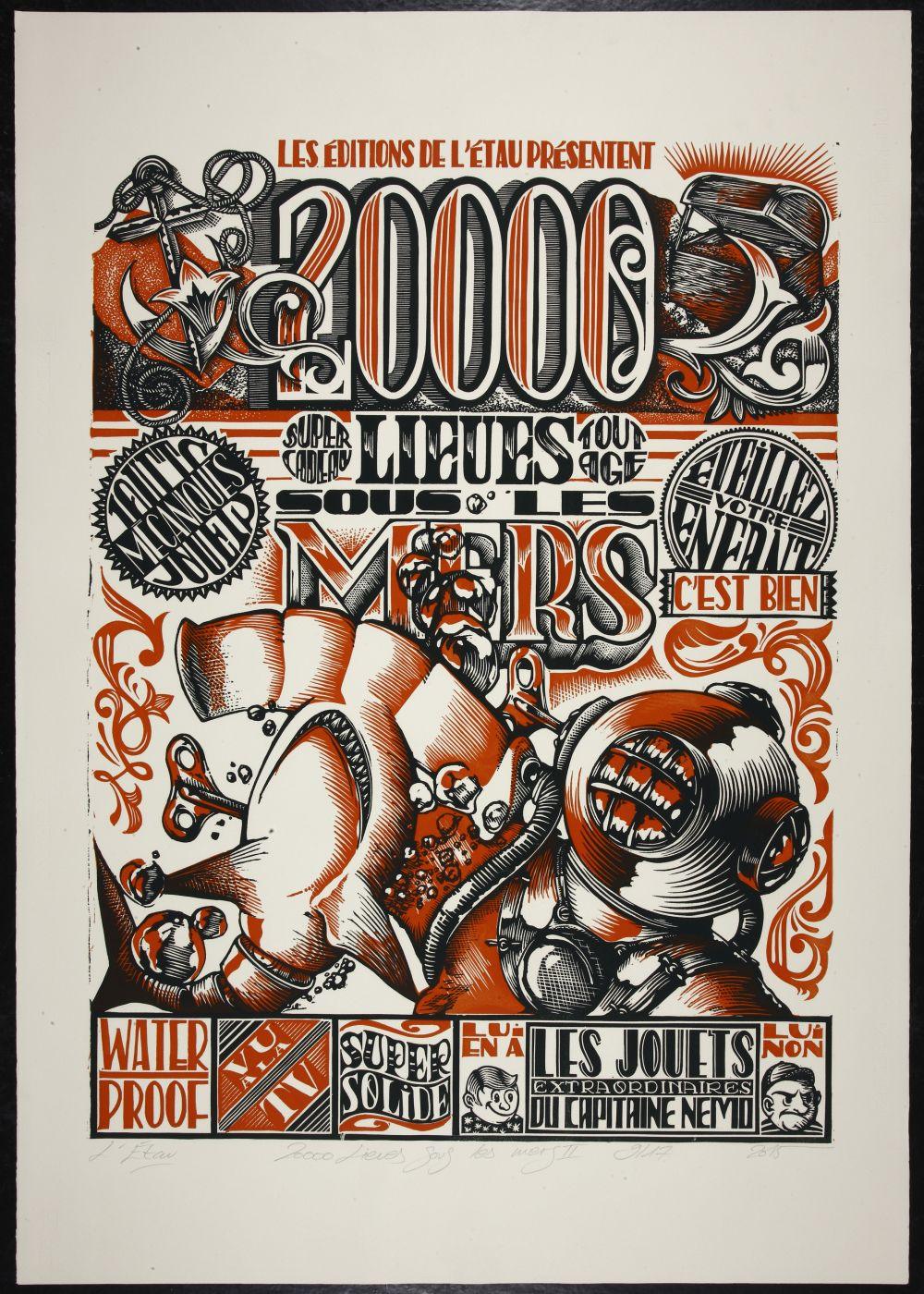
Benjamin Guyet
20,000 Leagues under the Sea
Linocut on paper – No. 9/17
Les Éditions de l’Étau, Nantes, 2015
MJV C515 (Purchased from the artist, 2015)
Les Éditions de l’Étau was founded by self-taught artist Benjamin Guyet, who has a fascination for the commercial art of the late 19th to early 20th century. He discovered linocutting in 2013. Since then, he has been creating his own posters announcing imaginary events; he designs his own typographies, giving the letters a warmer appearance that enhances his layouts. One of his series is devoted to Jules Verne and his novels, providing interpretations as offbeat as they are opportune.

George Roux
Christmas Gift Book poster, 1886
Lithograph
J. Hetzel & Cie, Strasbourg, 1885
MJV D38 (Joseph Laissus collection)
The sale of Christmas gift books was a major commercial event for Éditions Hetzel. It gave rise to the creation of advertising posters showcasing Jules Verne’s works in particular.
A clever layout incorporated blocks of text in which book titles are grouped by genre, series and age group, along with information on format, presentation and price. On the back, the publishing house provided an outline of its upcoming plans, with detailed notes on each of the year’s new titles. The posters were displayed on bookshops’ doors so that both sides could be read, providing readers with what was effectively a scaled-down catalogue.
Several models of posters were created each year. One of them was sometimes devoted to an especially important work or a leading author: Naturally enough, Jules Verne’s Extraordinary Voyages were treated to this sort of advertising.
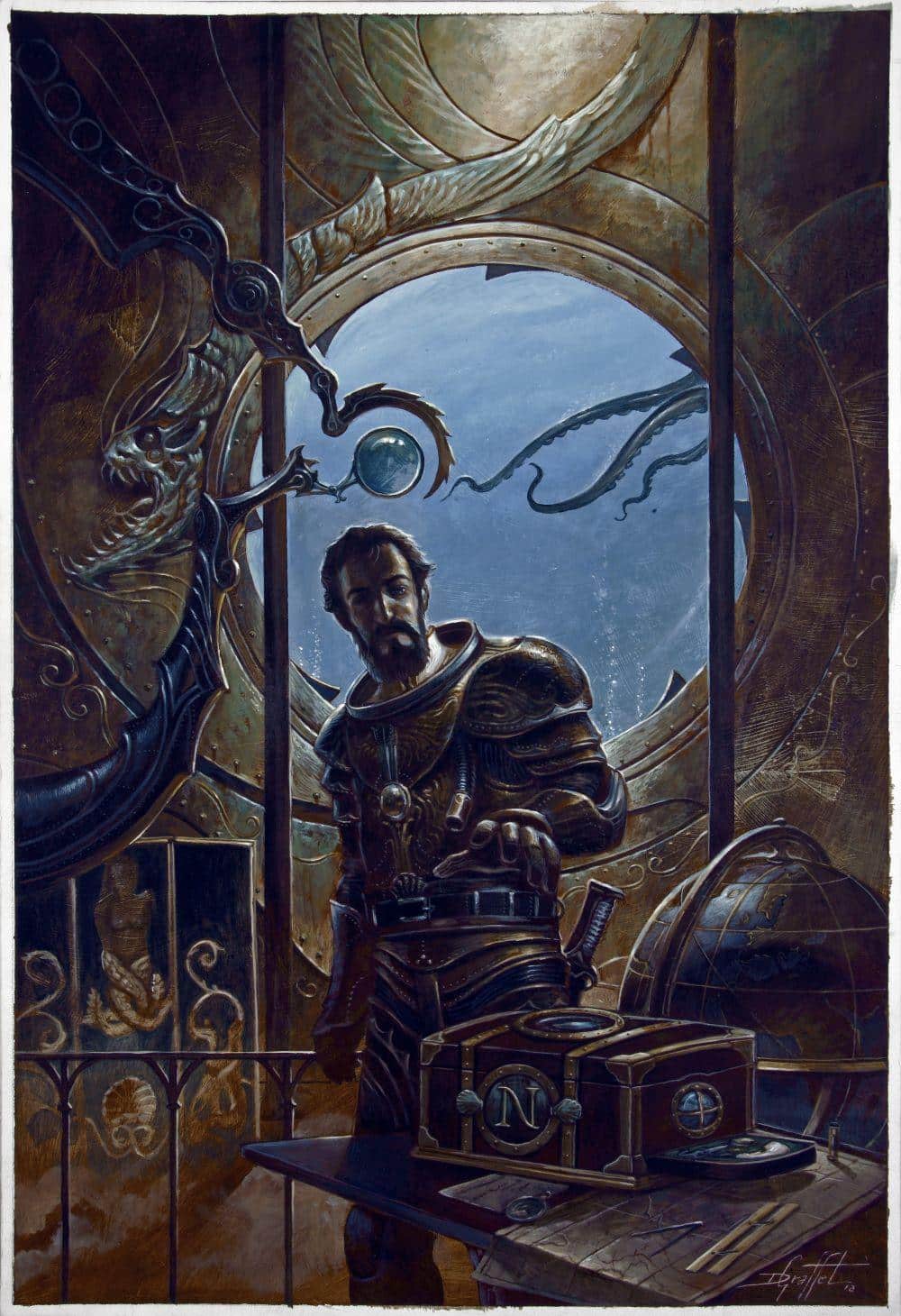
Didier Graffet
Portrait of Captain Nemo
Acrylic on cardboard, 2013
MJV C498 (Purchased from the artist, 2013)
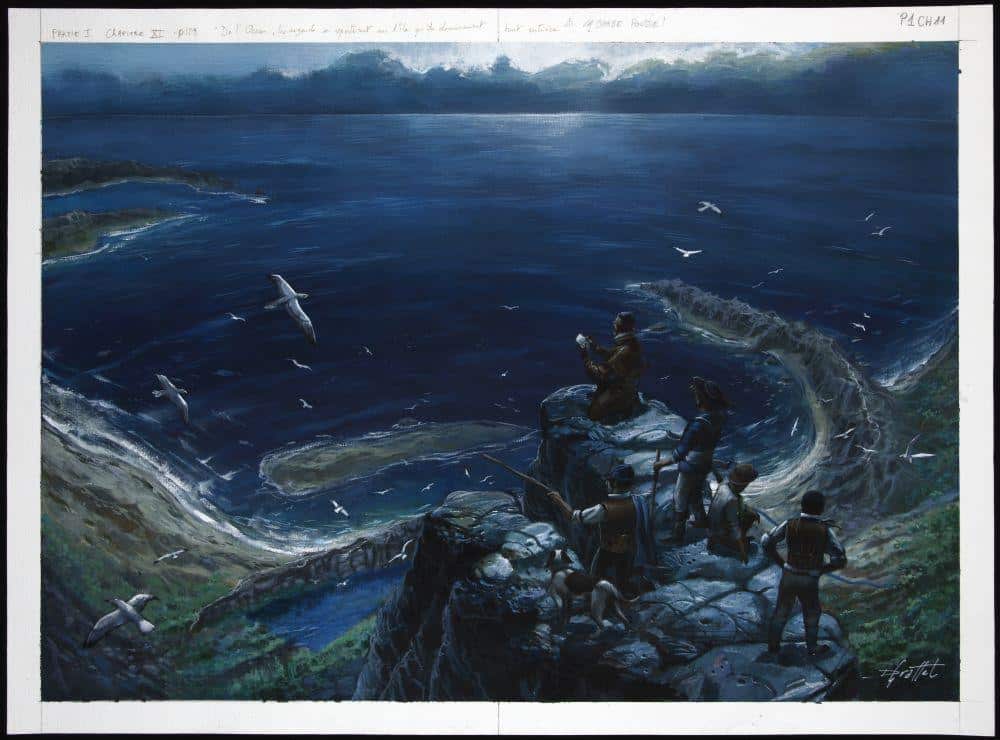
Didier Graffet
The Mysterious Island
Acrylic on paper
Illustration for the adaptation of the novel
Éditions Gründ, 2005
MJV C487 (Purchased from the artist, 2012)
Jules Verne
Lincoln Island
Original drawing for the novel The Mysterious Island
Pencil and ink on paper, 1873
MJV B235 – Exhibition print (Purchased with the support of the Fonds Régional d’Acquisition pour les Bibliothèques (FRAB), 2004)
After the castaways had explored the island and noted its characteristics, it “was spread out under their eyes like a map, and they had only to give names to all its angles and points, and to all its reliefs(…)”, Jules Verne concluded.
A keen cartographer, the writer himself drew the map to be reproduced in the novel. Very precisely located by means of its longitude and latitude, the island is shaped like a sort of fabulous dragon. Named in tribute to the castaways’ homeland, its toponymy is also borrowed from
the vocabulary of bestiaries when it comes to describing its features
(North and South Mandible Cape, Claw Cape, Serpentine Peninsula and Reptile Promontory).
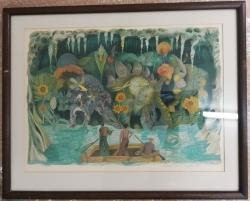
David McCall Johnston
Journey to the Centre of the Earth
Lithograph, 1978
MJV C58
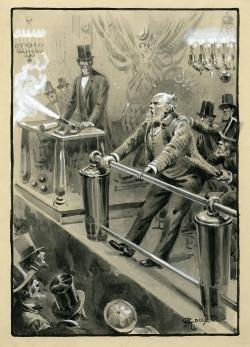
George Roux
From the Earth to the Moon
Original drawing for the Chapter 11 illustration
“Maston, I withdraw your permission to speak”, 1897
MJV C6 (Donated by Madame Bonnier de La Chapelle)
Requirements for the illustrations to Extraordinary Voyages were stringent. The artists called upon were expert in production of
detailed documentary drawings. They were genuine reporters of images, able to transcribe the atmosphere described in Jules Verne’s story due to the care they took over landscapes, scenery, costumes, accessories and situations.
The illustrators who collaborated with Jules Verne included Édouard Riou, Léon Benett, George Roux, Jules Férat and Alphonse de Neuville.

Jame’s Prunier
Around the World in 80 Days
Gouache on paper, for the illustrated adaptation of the novel
Éditions Gallimard, Paris, 1995
MJV C354 (Purchased with the support of the Fonds Régional d’Acquisition pour les Bibliothèques (FRAB), 2005)
A painter and illustrator born in 1959, Jame’s Prunier has collaborated in several republications of Jules Verne’s novels. In Around the World in Eighty Days, his illustrations provide the reader with windows open on the world’s diversity, landscapes and cultures, as in this colourful incursion into the streets of Yokohama.
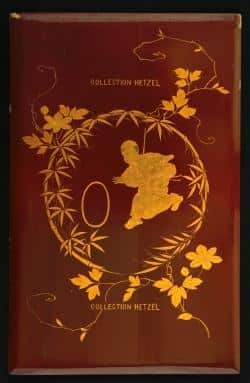
Advertising board for Éditions Hetzel
Lacquered wood, 1885
MJV G93

Jules Verne
The Will of an Eccentric
Éditions Hetzel, Paris, 1899-1902
MJV A243
Jules Verne
Celebrated Travels and Travellers
Éditions Hetzel, Paris, 1879
MJV A2805

Jules Verne
The Adventures of Captain Hatteras
The English at the North Pole and The Desert of Ice
Éditions Hetzel, Paris, 1866
MJV A70 and A71
Publication in inexpensive paperback form, softcover without illustrations. A volume that middle-class families could afford and intended for ordinary use.
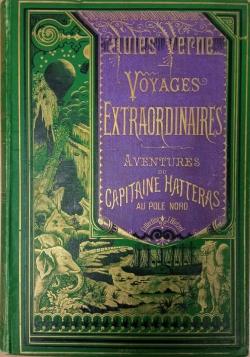
Jules Verne
The Voyages and Adventures of Captain Hatteras
Cartonnage binding “with banner”
Éditions Hetzel, Paris, 1875-1878
MJV A296
Publication in a large-format deluxe edition with richly decorated and gilded cartonnage binding and illustrated pages. A valuable item targeting bourgeois and aristocratic customers, given to children as a Christmas present or school prize.
Magasin d’Éducation et de Récréation
47th volume (12 issues from January to June)
Éditions Hetzel, Paris, 1888
MJV A6008
Prepublication as a serial in the pages of the Magasin d’Éducation et de Récréation. A widely disseminated format that helped publicise the publishing house and enabled assessment of the novel’s popularity.
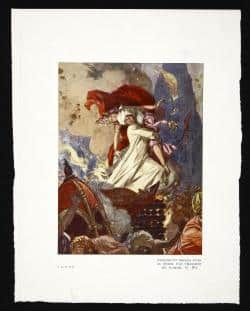
Auguste Leroux
Around the World in 80 Days
Original watercoloured pencil drawings with pastel highlights, printed for the illustrated adaptation of the novel
Éditions Hachette, Paris, 1838
MJV C558
In1914, the Hachette publishing house acquired Éditions Hetzel and became the exclusive holder of publication rights to Jules Verne’s works in France, until their entry into the public domain in 1966.
1938 saw the publication of a new edition of Around the World in Eighty Days illustrated by the painter and illustrator Auguste Leroux (1871-1854). The lead pencil drawing on tracing paper and the watercolour sketches on paper for the illustration captioned “Passepartout snatched Aouda from the pyre from which the flames were rising.” Testify to the artist’s skill in expressing Jules Verne’s story in images and the care he took over capturing the scene’s perilous character.
